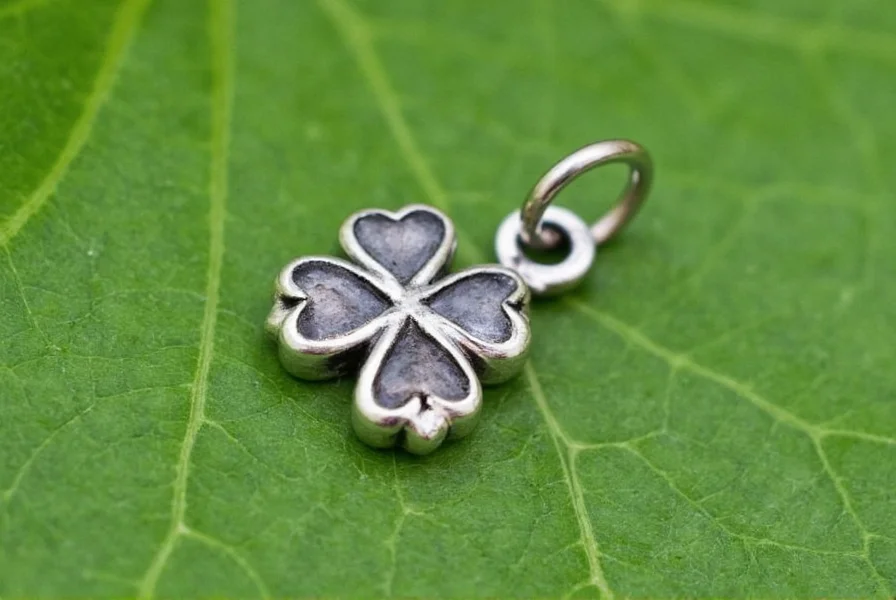Clover charms carry centuries of cultural significance and symbolic meaning that extends far beyond their simple botanical appearance. These delicate designs have evolved from ancient protective talismans to modern fashion statements while maintaining their core associations with luck and Irish heritage. Understanding the nuanced differences between three-leaf and four-leaf clover charms reveals a rich tapestry of historical beliefs and contemporary interpretations.
The Historical Roots of Clover Symbolism
The clover's symbolic journey begins in ancient Celtic traditions, where the three-leaf shamrock was considered sacred by druids. They believed the triangular shape represented earth, sea, and sky, offering protection against evil spirits. Saint Patrick later adopted the three-leaf clover in the 5th century to explain the Holy Trinity to Irish pagans, cementing its Christian symbolism of faith, hope, and love.
Four-leaf clovers entered folklore through medieval European traditions, where finding one was considered exceptionally lucky. The rarity of four-leaf variants (occurring naturally in about 1 in 10,000 clovers) contributed to their mystique. Historical records show that 16th-century herbalists documented four-leaf clovers as magical plants capable of revealing fairies and warding off misfortune.
Three-Leaf vs. Four-Leaf Clover Charms: Symbolic Differences
Understanding the distinction between three-leaf and four-leaf clover charms is essential for appreciating their cultural significance. The three-leaf clover charm, often called a shamrock charm, maintains strong ties to Irish identity and Christian symbolism. Each leaf represents:
| Leaf Position | Symbolic Meaning |
|---|---|
| First leaf | Faith |
| Second leaf | Hope |
| Third leaf | Love |
Four-leaf clover charms introduce an additional layer of symbolism, with the fourth leaf representing luck. This rare variation carries specific meanings across its leaves:
| Leaf Position | Symbolic Meaning |
|---|---|
| First leaf | Hope |
| Second leaf | Faith |
| Third leaf | Love |
| Fourth leaf | Luck |
Cultural Significance Across Societies
Clover charms have transcended their Irish origins to become globally recognized symbols. In Victorian England, four-leaf clover charms were popular sentimental gifts, often incorporated into mourning jewelry. German folklore associated clover charms with protection against nightmares, while American soldiers during World War II carried them as good luck charms.
The clover charm's meaning varies subtly across cultures. In Japan, clover charms (particularly four-leaf variants) are popular among young women as symbols of romantic fortune. Scandinavian traditions view the clover charm as a protective symbol against trolls and supernatural threats. These diverse interpretations demonstrate the charm's universal appeal while maintaining its core association with positive fortune.
Materials and Design Evolution
Traditional clover charms were crafted from simple materials like wood or bronze, but modern iterations showcase remarkable diversity. Sterling silver remains the most popular choice for clover charm jewelry, followed by gold and platinum for higher-end pieces. Contemporary designers incorporate gemstones into clover charm designs, with emeralds symbolizing the natural color of clover and diamonds representing dewdrops.
The evolution of clover charm craftsmanship reflects changing fashion trends while honoring traditional symbolism. Artisan jewelers now create intricate three-dimensional clover charms, while minimalist designers favor sleek, geometric interpretations. Vintage clover charms from the Art Nouveau period feature flowing, organic lines, whereas mid-century designs emphasize clean symmetry.
Wearing and Gifting Clover Charms
The placement of a clover charm carries subtle significance in various traditions. Wearing a clover charm necklace close to the heart symbolizes personal protection and hope, while bracelet charms represent shared luck with others. Pocket charms maintain the historical tradition of carrying a physical token of fortune.
Gifting customs for clover charms follow specific cultural protocols. In Ireland, presenting a four-leaf clover charm requires the giver to have found the clover themselves to transfer authentic luck. Many cultures consider clover charms appropriate gifts for graduations, new homes, or career changes as symbols of future prosperity. The enduring popularity of clover charms as graduation gifts stems from their representation of hope for the future.
Common Misconceptions About Clover Charms
Several misconceptions surround clover charms that deserve clarification. Contrary to popular belief, the four-leaf clover isn't exclusively Irish in origin—the luck symbolism developed across multiple European cultures. Additionally, while many assume all clover charms represent luck equally, three-leaf variants primarily symbolize Irish heritage rather than fortune.
Another common misunderstanding involves the botanical accuracy of clover charms. True shamrocks belong to the Trifolium genus, but many commercial clover charms depict wood sorrel (Oxalis), which has heart-shaped leaves. This distinction matters to botanical purists but doesn't diminish the charm's symbolic value.

Modern Interpretations and Enduring Appeal
Clover charms continue evolving in contemporary culture while maintaining their historical significance. Fashion designers incorporate clover motifs into seasonal collections, and tattoo artists create intricate clover charm designs that carry personal meaning for wearers. The symbolism has expanded beyond traditional luck associations to represent environmental consciousness, with some viewing the clover as a symbol of nature's delicate balance.
The enduring appeal of clover charms lies in their versatility—they work as subtle everyday accessories or meaningful statement pieces. Unlike more overtly symbolic jewelry, clover charms offer layered meaning that resonates differently with each wearer while maintaining universal recognition. This adaptability ensures their continued relevance in both jewelry design and cultural symbolism.










 浙公网安备
33010002000092号
浙公网安备
33010002000092号 浙B2-20120091-4
浙B2-20120091-4